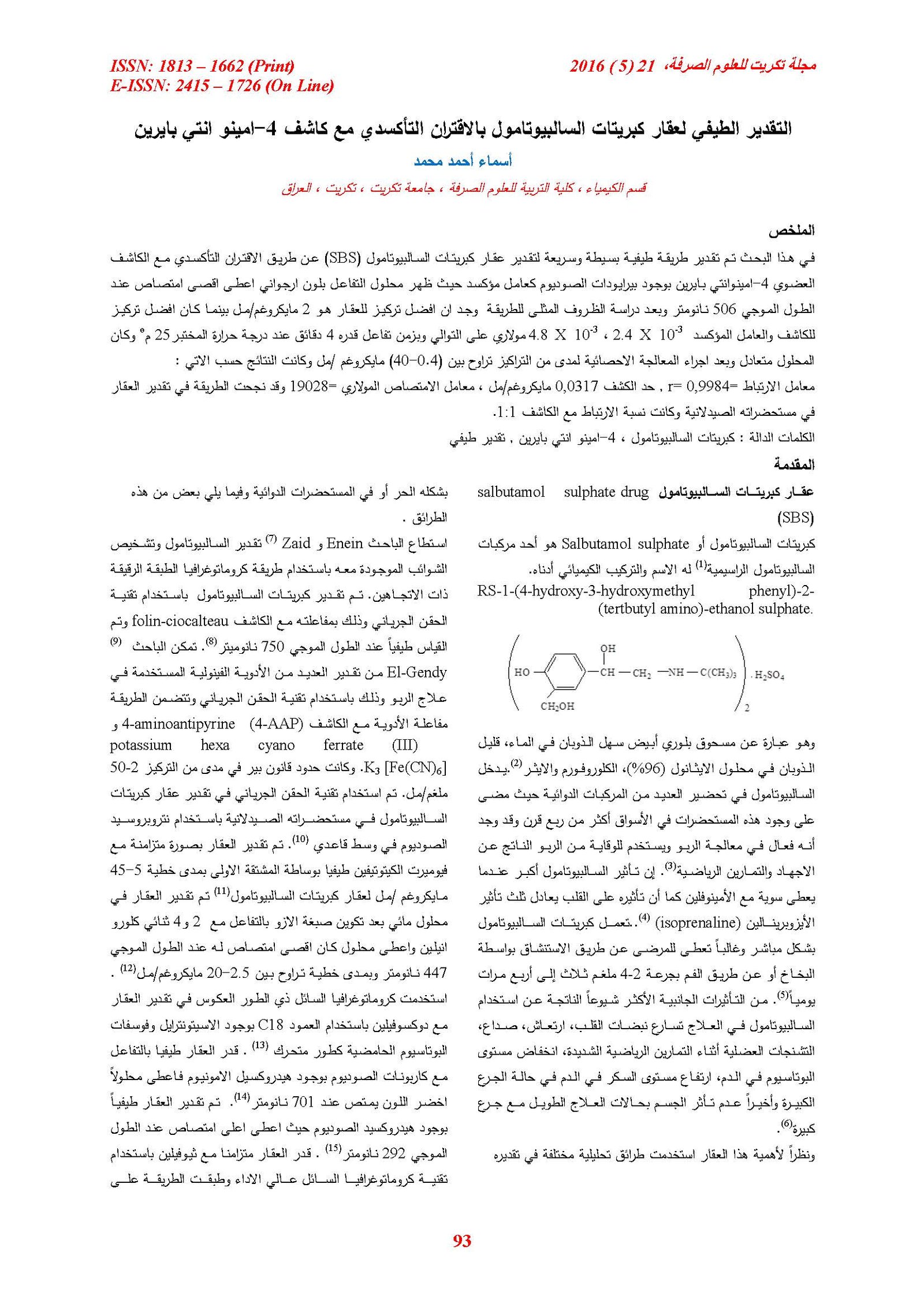Spectrophotometric Determination for Salbutamol Sulphate drug by Oxidation Coupling with 4-Aminoantipyrine
Main Article Content
Abstract
This research introduce simple & fast spectrophotometric method for determination of Salbutamol Sulphate drug by Oxidation Coupling with 4-aminoantipyrine(4-AAP) and NaIO4 as Oxidant reagent. Purple color solution is found which give maximum absorbance at 506 nm.
The optimum conditions of the method are as the follow :
(2 µg/ml, 2.4X10-3 M and 4.8X10-3 M) concentration of drug ,reagent and oxidation reagent respectively with 4min as a reaction time at room temperature in neutrality solution.
The results of statistical treatment of linear concentration range (0.4- 40) µg/ml are: r= 0.9984, Detection limit = 0.0317 µg/ml and Molar absorption coefficient =19028 L/mol.cm , This method is applied successfully for the determination drug in pharmaceutical formulation with ratio 1:1.
Article Details

This work is licensed under a Creative Commons Attribution 4.0 International License.
Tikrit Journal of Pure Science is licensed under the Creative Commons Attribution 4.0 International License, which allows users to copy, create extracts, abstracts, and new works from the article, alter and revise the article, and make commercial use of the article (including reuse and/or resale of the article by commercial entities), provided the user gives appropriate credit (with a link to the formal publication through the relevant DOI), provides a link to the license, indicates if changes were made, and the licensor is not represented as endorsing the use made of the work. The authors hold the copyright for their published work on the Tikrit J. Pure Sci. website, while Tikrit J. Pure Sci. is responsible for appreciate citation of their work, which is released under CC-BY-4.0, enabling the unrestricted use, distribution, and reproduction of an article in any medium, provided that the original work is properly cited.
References
1- Al-Timimy, B. K. “M. Sc. Pharmacy Thesis”, Baghdad University, (1998).
2- Lund, W. “The Pharmaceutical Codex”, 12th Edn., The Pharmaceutical Press, London, (1994).
3- Dolley, C. “Therapeutic Drug”, Churchill Living Stone, London, (1991).
5- Reynolds, J. E. F. Martindale, “The Extra Pharmacopeia”, 31th Edn., The Pharmaceutical press, London, (1996).
6- Berges, R. Segura, J. Ventura, R. Fitch, K. Morton, A. and Torre, X. Clinical Chemistry, (2000), 46, 1365-1375.
7- Enein, H. and Zaid, S. Anal. Lett., (2001), 34, 2099-2110.
8- Satinsky, D. Karlicek, R. and Svoboda, A. Anal. Chim. Acta, (2002), 455, 103-109.
9- El-Gendy, A. Anal. Lett., (2000), 33, 2927-2938.
10-.Al Abachi. M and Hind Hadi, International Journal of Research in Pharmaceutical and Biomedical Sciences, Vol. 3(3)Jul – Sep 2012
11- Parth R. Joshi, Shraddha J. Parmar, and Bhavna A.Patel, International Journal of Spectroscopy Volume 2013(2013), Article ID 589218,6pages.
12- Maha Kadim Salman, Baghdad Science Journal Vol 7(1)2010.
13- Deepak. J, Pratibha. P and Nilesh. J, Der Pharmacia Lettre , 2011:3(4) 56-62.
14- Manasa.A, Mohammed. A and Sudheerbu. I , The Experment , Feb,2013 Vol.7(4), 445-449.
15- Eswarudu. M, Sushma. M and Yamini. K, International Research Journal of Pharmacy 2012,3 (4), 423-425.
16- Maithani. M& Singh. R, J Anal Bioanal Tech 1:116 ,2012.
17- Chitlange. SS and Chaturved. K, J Anal Bioanal Tech 2:117, 2012.
